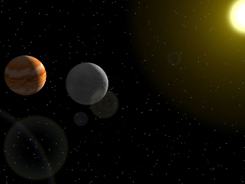 |
 |
|

| ||||||||||||||||
 | ||||||||||||||||
|
CTC Visualizations Help Explain the Mysteries of Deep
Space | |
|
04/07/1997 |
|
|
Ithaca, NY | |
|
With the help of data from researchers at the
Massachusetts Institute of Technology and computer graphics animation from
Wayne Lytle, of the visualization department at the Cornell Theory Center
(CTC), viewers of PBS in April will be able to watch planets interact with
each other and the star they orbit.
The first of a three-part PBS series, "Mysteries of Deep Space," will
be broadcast on Monday, April 14, with the second and third parts airing
on the two following Mondays.
The two researchers are Frederic A. Rasio, an assistant professor in
the department of physics at MIT, and Eric B. Ford, an MIT sophomore and
physics major. Following the discovery of about a dozen planets in the
last year, Rasio and Ford ran simulations on CTC's IBM RS/6000 Scalable
POWERparallel Systems (SP) to look at solar system formation.
"The massively parallel SP system is ideally suited to this
investigation because it allows us to perform many thousands of orbital
integrations in a relatively short time," Rasio says. "A large number of
integrations is necessary if we want to be able to estimate the relative
probabilities of forming different kinds of planetary systems."
What the researchers found was the likelihood that the existence of
life-sustaining planets, such as Earth, might be rarer than was previously
thought. Their work will be featured in the third episode of the
series.
 "Discoveries such as these are causing revisions in the way we look
at planets," according to PBS producer, Thomas Lucas. "Rasio and Ford's
findings suggest that solar systems like ours might be unique. Their
simulation offers an explanation of why many of the recently discovered
planets orbit so close to their stars or why they have such eccentric
orbits. And Wayne has very artfully illustrated this for our
series."
What seems to happen is that two planets orbit their common star, and
eventually their orbits come close enough together that the planets'
gravitational forces affect each other. This interaction can lead to an
instability, and ultimately, to the ejection of one planet out to a large
distance while the other planet plunges in much closer to the star.
Planetary systems that could support intelligent life probably require
planets that can remain for billions of years on stable, circular orbits.
The results of Rasio and Ford suggest that such stable systems might be
very rare. | |
|
About the Cornell Theory Center The Cornell Theory Center is supported by the National Science Foundation, New York State, the National Center for Research Resources at the National Institutes of Health, IBM, and other members of CTC's Corporate Partnership Program. | |
 | ||
|
©2005 Cornell
University | A Cornell Theory
Center Web site | Copyright
Statement Please send comments on this site to the webmaster. |
 |